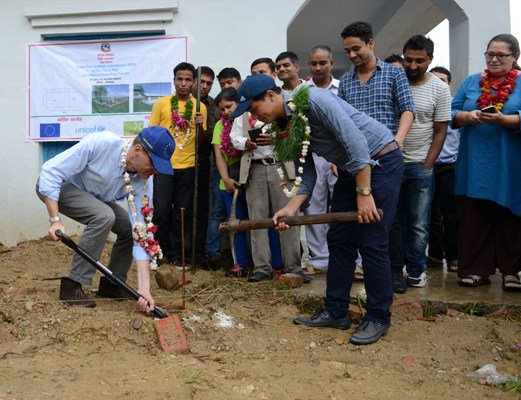
One week on from the earthquake in Nepal, UNICEF says the health and wellbeing of children affected by the disaster are hanging in the balance – as many have been left homeless, in deep shock and with no access to basic care. With the monsoon season only a few weeks away, children will be at heightened risk of diseases like cholera and diarrhoeal infections, as well as being more vulnerable to the threat of landslides and floods.
“The earthquake has caused unimaginable destruction,” said Rownak Khan, UNICEF Deputy Representative in Nepal. “Hospitals are overflowing, water is scarce, bodies are still buried under the rubble and people are still sleeping in the open. This is a perfect breeding ground for diseases.”
The April 25 earthquake flattened more than 130,000 homes and left 3 million people in need of food assistance. Some 24,000 people are currently staying in 13 camps in Kathmandu. In a country where just over 40 per cent of children are stunted, fears for children’s nutrition are rising. At least 15,000 children with severe acute malnutrition require therapeutic feeding. There is also an urgent need for children in the 12 most affected districts to get back to their normal routine by setting up child-friendly spaces, opening schools and providing access to basic services, such as health and water.
As soon as the earthquake struck one week ago, UNICEF used its pre-positioned relief supplies to mount an emergency response and was able to provide aid, including tents to serve as emergency clinics at hospitals, tarpaulin for shelter, water trucking services in informal camps, water purification tablets and hygiene kits.
UNICEF is broadening its response so that children in the most severely affected communities, including those in hard-to-reach areas beyond Kathmandu, are provided with lifesaving services and supplies.
"We have a small window of time to put in place measures that will keep earthquake-affected children safe from infectious disease outbreaks – a danger that would be exacerbated by the wet and muddy conditions brought on with the rains," said Khan. “That’s why it’s so crucial to get essential medicine, medical equipment, tents and water supplies out to these areas now.”
In the past week, UNICEF has flown in more than 85 tons of aid, including tents, plastic sheeting, blankets and life-saving medicines, Set up child friendly spaces in informal camps, to offer support to help children recover from their experiences, as well as a safe place where they can play and learn.
According to a press release issued by UNICEF, it also delivered aid to remote areas outside the Kathmandu valley – including in Kavre and Gorkha districts, where UNICEF teams provided thousands of people with soap, water purification tablets, tarpaulins and buckets. In Dhading district, hygiene and family kits and water purification tablets have been dropped to seven remote villages using helicopters and set up psychological support services in Gorkha, Kaski, Sindhuli, Kavre, Ramechhap and Kathmandu.
On Sunday live on-air programs begin on national radio aimed at providing life-saving information and also expert counselling for children, women and families living in remote parts of the districts hit by the earthquake. The programmes will be aired four times throughout the day.
UNICEF has launched a US$50 million appeal to support its humanitarian response to the earthquake in Nepal for the next three months.
Lending his voice to the children of Nepal, UNICEF Ambassador Orlando Bloom, who has visited Nepal twice with UNICEF, has recorded an appeal urging support for UNICEF's emergency efforts. The video can be accessed here.
- TANAHU HYDROPOWER PROEJCT: A Significant Achievement
- Apr 15, 2024
- AMBASSADOR HANAN GODAR: Sharing Pain With A Nepali Family
- Mar 30, 2024
- VISIT OF KfW AND EIB TO NEPAL : Mission Matters
- Mar 25, 2024
- NEPAL BRITAIN SOCIETY: Pratima Pande's Leadership
- Mar 24, 2024
- NEPAL ARMY DAY: Time To Recall Glory
- Mar 15, 2024
















